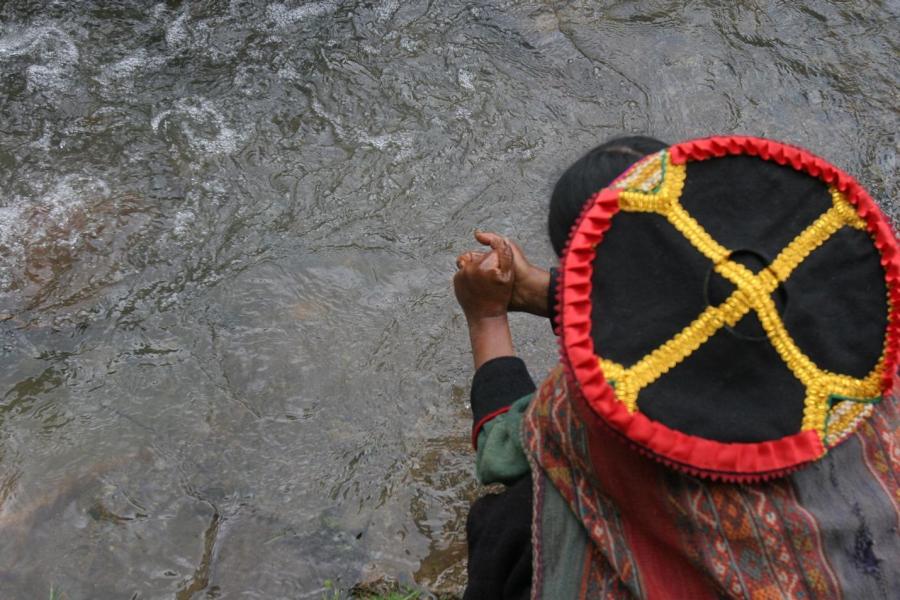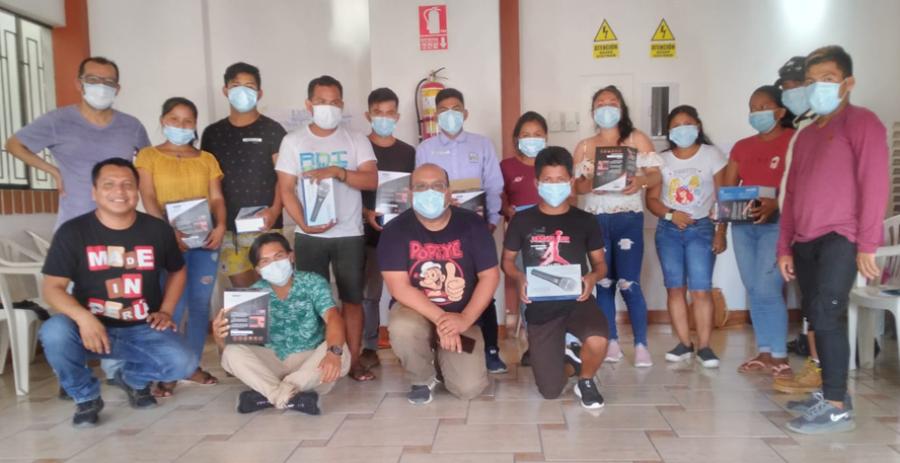Reports in the Lima press on January 23 and 24, 1984, described a bow and arrow attack by a group or 20 to 50 naked and painted members of the "Pirumashco tribe," occurring on January 22 in the Isthmus of Fitzcarrald area of Mann Province, Madre de Dios, Peru. The victims were a crew of heliport construction workers; Segundo Brito Murallari, a 16-year-old trail clearer, received a 2-inch arrow wound in the back.
The attack coincided with a visit to the location by Peru's President, Fernando Belaunde Terry. Brito was transferred by helicopter to the Domican Mission at Sepahua on the Urubamba River, where his wound was treated by the President's doctor.
Local authorities had previously warned President Belaunde of the possibility of a hostile confrontation with these indigenous peoples. Twice before, on December 8 and again in early January, his visit had been postponed because of threats to his safety. Belaunde was accompanied by a contingent of the Peruvian Navy which responded to the attack with gunfire from helicopters. The indigenous attackers quickly dispersed. There are no reports of casualties among them.
The location and the history of previous incidents suggest that the "Pirumashcos" are probably Yaminahua, although they may be an Amahuaca, Machiguenga or Piro subgroup.
Whoever they are, these indigenous people have, by choice, remained relatively isolated from the outside world in one of the last "protected" areas of the Amazon Basin - the Manu National Park.
The Manu National Park is a wilderness area of tropical forests of southeastern Peru (Departments of Madre de Dios and Cusco) set aside for conservation and scientific purposes by the Peruvian Government in 1973. In 1980 UNESCO recognized it as a conservation unit of unique value and importance in the Man and the Biosphere program. It encompasses one of the last intact expanses of primary tropical forest, containing perhaps the world's richest variety of animals, birds, and plants in an area which includes high cold thorn forest and humid tropical forests of the low jungle.
The Park is also the home for at least three different indigenous populations, which by law are guaranteed the right to remain within the boundaries of the park (although without property rights) and continue their traditional way of life, including hunting, fishing, gathering, and slash-and-burn horticulture. They are not allowed to hunt with firearms nor fish with explosives. These techniques, however, have been introduced by outsiders in spite of very strict legal restrictions against contact with the indigenous peoples.
Since 1981, the Royal Dutch Shell Petroleum Company and its subcontractor GeoSource, Inc., have conducted seismic exploration for oil in a large oil exploration concession, including the Isthmus of Fitzcarrald area within the Manu National Park, where the January 22 incident took place. Seismic exploration involves clearing trails at 5-kilometer intervals to detonate explosive devices for gauging the potential for hydrocarbon reserves. These explosions are disturbing to both the people and animals living in the area. Moreover, such operations involve a large labor force spread out over a vast territory, rendering contact with indigenous peoples - as well as the careless depredation of forest flora and fauna - inevitable.
Shell's seismic exploration in this area terminated in mid-1983, but the company's negotiations for two new concessions to the east of the current location would also affect the Park and its inhabitants.
The construction of a heliport is the first step toward the opening of a new navy base in the Isthmus of Fitzcarrald, a project which directly and openly violates the Park's purpose as a conservation unit. Naval units would be transferred there from the Lagarto Navy Base on the Madre de Dios River.
The only justification of a navy base in this area, which is a watershed between the Urubamba-Ucayali and Manu-Madre de Dios River Basins, is to carry out another project announced by President Belaunde: the interconnection of these river basins by a canal which would permit navigation by small craft during the rainy season months.
It is difficult to justify this interfluvial connection in economic terms since the Urubamba-Ucayali and Manu-Madre de Dios Basins are of similar geographical character and have little to exchange. Moreover, the distance between urban population centers from one side to the other is more than 500 miles.
The Isthmus of Fitzcarrald is the watershed crossed by the Peruvian rubber baron and trader Carlos Fermin Fitzcarrald in 1894, an exploit dramatized, although inaccurately, by the West German producer Werner Herzog's recent film "Fitzcarraldo."
Fitzcarrald and subsequent rubber collectors who crossed the watersheds from the Urubamba-Ucayali Basin were unable to develop, economically, rubber extraction in the Madre de Dios region of Peru. Prior to 1906, most of the rubber exported from the Madre de Dios had to be taken through Bolivia and Brazil and not via the watershed route. The real "boom" in the rubber industry for that region occurred after 1906 when an American firm, the Inca Rubber Company, completed a mule trail connecting the Tambopata River in eastern Madre de Dios with the highlands of Puno from which there was rail transportation to the Pacific coast. In 1915, rubber production from Madre de Dios reached 790,000 kilograms.
The current canal project is considered the dream - some say obsession - of 71-year-old President Belaunde. For indigenous peoples and Manu Park ecology, however, the canal would be disastrous. The volume of labor, equipment, and explosives necessary to excavate the canal and the long access route through the Park would eliminate any meaningful protection of the Park's indigenous population as well as it's flora and fauna.
Meanwhile, another Belaunde dream, the extension of the Jungle Marginal Highway across the Isthmus of Fitzcarrald through the Manu National Park, along the Manu and Madre de Dios Rivers to the Bolivian border, is also being proposed. Surveying for that project is scheduled for later this year. The Trans-Amazonian Highway experience in Brazil provides an indication of what the consequences of this road would be for the indigenous peoples and the ecology of the region.
The economic utility of such a highway is questionable, as are the prospects for its maintenance in this area where rainfall and erosion are unusually high. Moreover, Peru's geopolitical interests might be better served if the highway route were to be extended from the port of Atalaya, at the mouth of the Urubamba River, along the Purus River to the Brazilian border, where it could connect with existing Brazilian roads. There is currently no Bolivian highway which might connect with the Jungle Marginal Highway's proposed Manu-Madre de Dios route.
Any jungle highway construction will undoubtedly cause difficulties for indigenous peoples and endanger the jungle ecology. However, the Purus route would not affect any indigenous population which still has no permanent relations with non-indigenous peoples. Moreover, it would spare the Manu National Park.
Another threat to indigenous people of the Manu National Park is a request by Father Javier Ignacio Iraizoz, a Spanish Dominican priest, for permission for the Tayakome Machiguenga community to cut timber in an area along the Manu River. The Tayakome community is located on the Manuy River well within the Park. The timber concessions have been solicited for an area just outside the Park but within the Manu Reserved Zone, a sort of buffer zone created in 1980 to protect the eastern flank of the Park. Timber cutting is officially prohibited in both the Park and the Reserved Zone, but Father Ignacio has requested that an exception be made in this case.
The Machiguenga of the Tayakome community, who have traditionally maintained a lifestyle largely independent of missionaries and a cash economy, have never been collectively consulted about whether they want to cut timber. The Summer Institute of Linguistics had a presence there in the 1960s and early 1970s but left in 1973, taking some of the Machiguenga with them to the Camisea River, outside the Park. Those Machiguenga who have remained at Tayakome have done so in resistance to missionary pressure.
Father Ignacio runs a sawmill at the Shintuya community of Amarakaeri and Wachipaeri natives on the Alto Madre de Dios River in Manu Province but outside the Park. He also has a monopoly on gasoline distribution in the region. A year ago he obtained a donation from a European charitable organization to provide an outboard motor for the Tayakome community. Members of the Tayakome community report that Father Ignacio has demanded they work in the sawmill in order to pay for the outboard motor which Father Ignacio received as a donation. The community, which now operates the outboard motor on one of their canoes, has balked at this demand. So, the priest now wishes to commit them to cutting timber within the Manu Reserved Zone nearer their community.
The Machiguenga of the Tayakome community are now a relatively strong, healthy, proud, and independent people. By contrast, the Amarakaeir and Wachipaeri at Shintuya, who work in Father Ignacio's sawmill, find little time to hunt, fish, gather, and cultivate their gardens. As a result, they suffer from serious malnutrition. Physicians who have visited Shintuya in the past two years report that from 50 to 80 % of the Shintuya population have active cases of tuberculosis for which the Dominican mission provides no systematic treatment.
One can predict a similar future for the Tayakome Machiguenga should Father Ignacio succeed in gaining Peruvian Ministry of Agriculture approval for the timber cutting concession and for the Tayakome Machiguengas to work in it.
Meanwhile, the Manu National Park is protected only by three guard posts, two on its eastern flank and one at a southern entry. There is no guard post in the Isthmus of Fitzcarrald area on its western border nor is there any aerial surveillance. Moreover, there is no budget to carry out either anthropological or conservation programs. Most of the zoological and botanical studies being conducted there are sponsored by North American and European institutions. The need for an international campaign to save the Manu National Park and its indigenous inhabitants is urgent.
Article copyright Cultural Survival, Inc.



